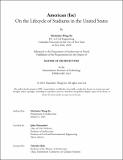American (Ise): On the Lifecycle of Stadiums in the United States
Author(s)
Wang-Xu, Mackinley
DownloadThesis PDF (38.03Mb)
Advisor
Ochsendorf, John
Terms of use
Metadata
Show full item recordAbstract
When the Kingdome in Seattle was completed in 1976, it was celebrated as a marvel of modern engineering, expected to last for centuries. Yet, in an ironic twist, it was demolished by implosion in 2000, surviving only twenty-four years. The Kingdome epitomizes the issue of short lifespans that has plagued American stadiums since the post-war era. A broad survey of these structures reveals an average lifespan of just three decades—a startlingly brief tenure for buildings of their scale and significance. These stadiums also follow a distinctive model of renewal. Similar to the Shikinen Sengu ritual at the Ise Shrine, a new stadium is often constructed adjacent to its predecessor. However, unlike Ise, where materials from the old shrine are reused and disseminated throughout Japan’s network of shrines, old stadiums are almost always demolished and discarded. This thesis seeks to superimpose Ise as a model onto American stadiums, envisioning an architecture that embraces both impermanence and longevity through circularity. Investigations into the barriers to circularity specific to stadiums serve as the foundation for design proposals, spanning scales from the detail to the site. The project ultimately imagines a stadium in a constant process of disassembly and renewal, where its spatial and programmatic potential challenge paradigms of completeness. In the context of a climate crisis demanding waste reduction, and for a typology notorious for its excess, stadiums can learn to do more with less.
Date issued
2025-02Department
Massachusetts Institute of Technology. Department of ArchitecturePublisher
Massachusetts Institute of Technology